This was published 5 years ago
From disasters and plagues to celebrations: How Brisbane came to love its river
From sewer to the backdrop for colourful festivals, the notion that residents have always loved the Brisbane River is a "new invention".
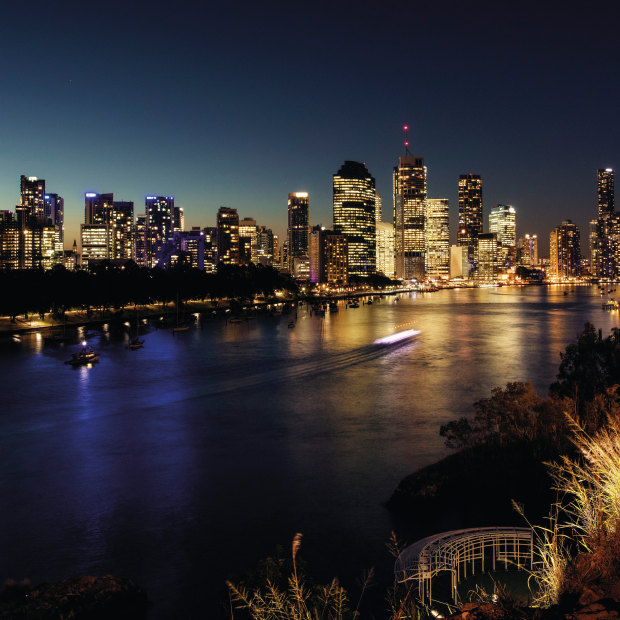
The sun sets on the Brisbane River, which was once treated like a sewer.Credit: Tourism and Events Queensland
For years, it was unloved and neglected by Brisbane.
The Brisbane River, a natural feature central to the lives of First Australians for thousands of years, served a more utilitarian purpose for the early white settlers.
That of a sewer.
Luckily, our attitude to the river has also changed over the years, but it all could have been so much different had colonial pre-Queenslanders followed the original plan.
Originally, the region’s convict settlement was at Redcliffe, north of Brisbane. There, water was hard to come by and frequent clashes with the Indigenous population meant the Redcliffe site was moved to present-day Brisbane in 1824.
But when the penal settlement was closed in 1842 and became the northern New South Wales free settlement colony, much of Brisbane’s early convict history was lost.
“Most of the convict buildings were demolished for quick building materials and the free settlers didn’t want to be lumped with the stain of the convict period,” Brisbane historian Jack Ford said.
“The old windmill [Wickham Terrace] and the Commissariat Store [William Street] are the only two remaining convict buildings.”
When Queensland separated from NSW in 1859, the penal settlement was chosen as the main development site for the state and wharves were built on the site where South Brisbane is today.
New industries emerged after the 1890s and the increased development led to the river being “used as a sewer”, according to Dr Ford.
“The river was actually quite popular for recreation with swimming baths along the banks, sandy beaches and picnic areas, but they were gone by the start of World War II with the pollution and effects of dredging to keep the shipping channels open,” he said.
Fellow Brisbane historian Helen Gregory said there used to be an impressive beach underneath the Indooroopilly railway bridge [Albert Bridge] after flooding deposited land amounts of sand beneath the structure, which had been washed away upstream.
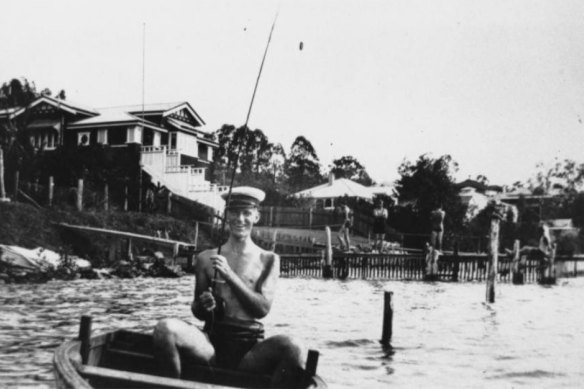
Fishing for dinner in the Brisbane River at Norman Park c. 1934.Credit: State Library of Queensland
Visitors could sunbake, swim and there were nearby kiosks to take advantage of the beachgoers, but later, a flood washed the beach away once again.
It was an early taste of what would become a theme in Brisbane.
Ms Gregory said before the sandbars and channels were dredged, it was possible to walk across the Brisbane River near the mouth and near Hamilton at low tide.
The river played a key role during World War II, according to Mr Ford, because it was heavily used by supply ships and anti-aircraft batteries were built along the riverbanks in case Japanese bombers tried to use the line of the river to find their way to the city.
Post-war industrialisation and a population boom resulted in an increase in riverfront businesses and riverfront homes were replaced by flats in the likes of South Brisbane, West End and Milton.
However, attitudes changed towards riverfront property in 1974 in the wake of the January flood, which resulted in greater emphasis on flood mitigation projects.
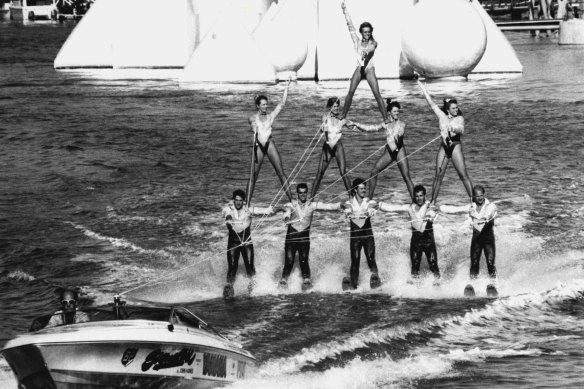
Water skiing prowess on display at World Expo '88.
The continual growth of river crossings and increase in ferry services along the river were put to the test during World Expo '88, as international visitors poured into the city.
“People fell in love with the river again because the ferries were the easiest way to get to Expo '88,” Dr Ford said.
“South Bank … was the creation of post-Expo, people could see the river in a positive light for 100 years or more.
“You could see the change in message and attitude towards the river, old houses and businesses closed, and most of both sides of the river were lined with high-rise apartments and marketed on the basis of river views.”
Ms Gregory said because the river flooded on several occasions and also had a foul smell at times, it was not loved by locals.
“There have been a lot of wrong perceptions about Brisbane having always loved the river … the idea that Brisbane has always loved the river is a new invention considering how long settlers have been here,” she said.
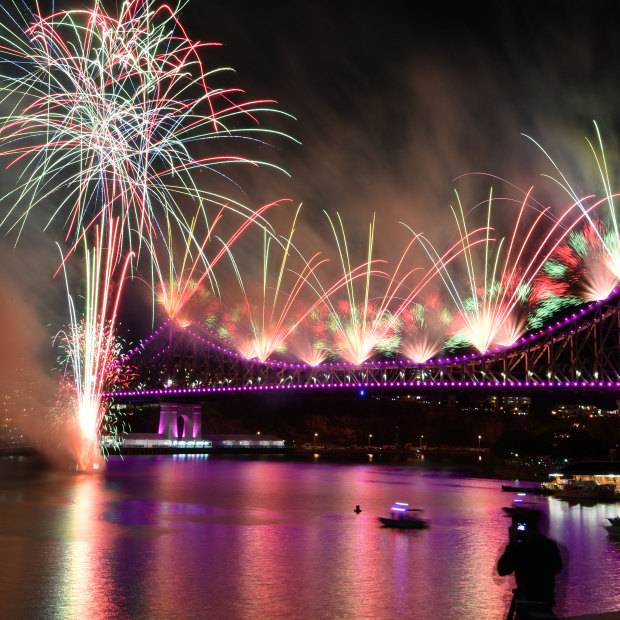
Riverfire is a celebration of the Brisbane River, highlighting its importance to the city's cultural life.Credit: AAP
“For a long time, Queensland was not as wealthy as other colonies, so being able to afford to build bridges over the river was a problem.
“It generated a lot of misperceptions and division in the city and kicked off the north-south divide.
“With the southside being the centre of the port with fish markets and coal wharves, it was seen as unglamorous and the suburbs got tarred with that too.”
Dr Ford said there was now greater recreational use of the river than ever before through sailing and rowing. This, coupled with the many events such as Riverfire that champion or feature the river, symbolised how essential it is to Brisbane life.
But before all that, since time immemorial, the Brisbane River - or Maiwar - played an important role in Indigenous communities.
Yuggera elder Deborah Sandy said there used to be 200-300 canoes on the riverbank, which the traditional landowners would use to cross to the other bank.
The area around the botanic gardens was significant for women because there was a billabong and an abundance of native food, including fish and possums.
Aunty Deb also has fond memories of growing up on the river.
“I grew up fishing and swimming in the river in the ‘70s and ‘80s,” she said.
“I used to have swimming races with my cousins and older brother around New Farm near the boat ramp where the current wasn’t so strong and we used to wade out into the middle of the river.
“The beauty of the Brisbane River too was the sandbanks, particularly on the bends where there used to be little beaches, which we called Yeronga – meaning sandy country.
“I also used to take my kids there until about 1995 when the river became polluted. We’ve never been swimming there again and there are no fish or crab anymore, just heaps of catfish.”
Aunty Deb’s great great grandfather was the Indigenous headman who was king of the southside and his story has been passed down through the generations.
Her ancestor lived in the botanical gardens before his father took him into Ipswich bushland to escape the English settlers at the age of six.
He later travelled to the Gold Coast where he met a woman, stayed there and had children.
In 1895 he was removed from his Southport camp and taken to a mission in Ipswich, where he died six years later.
“Imagine being taken away from the river and the coast and being shoved in a little mission in a dry area of Ipswich,” Aunty Deb said.
“A lot of people ended up dying there because they needed a special pass to leave the mission and even if they did get back home the English had started building infrastructure on their homeland.
“Our elders were also not allowed to speak their traditional language in the missions and were made to speak English.
“Thankfully, English linguists recorded the various traditional languages so present-day elders are trying to bring them back now.
“That is what the river means to me, my people and Aboriginal communities.”
Five historic tales from the Brisbane River
Shark attack near Kangaroo Point
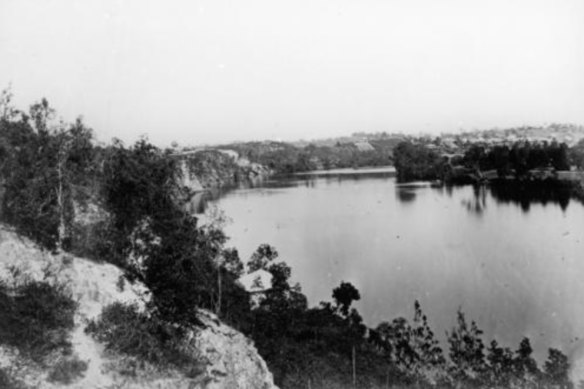
The Brisbane River circa 1878.Credit: State Library of Queensland
In our last issue was published a brief telegram from our Brisbane correspondent of an attack on a boy in the Brisbane river by a shark. The subjoined details of the sad occurrence are taken from the Brisbane Telegraph of Friday last:
One of the most heartrending bathing accidents which it has ever fallen to us to record occurred yesterday evening in the river at what is known as the Deep Rock, opposite Kangaroo Point sawmills.
The place has been and is still a favourite place for “bogeying,” although warnings have been given on several occasions of the probabilities of large sharks “planting” themselves among the rocks at the bottom, the water being almost still at the particular spot, or only eddying.
There were five youngsters bathing there about 5.20 pm, named Alexander Drury, Victor Dury, Arthur Taylor, Alexander Dart, and M. Bergin.
The first-named was the only one in the water, and we believe, had been racing with his brother who had got out, the others being engaged in dressing, except Bergin who, having just come, was preparing to enter the water.
The boys were all sitting on a log which lies here, and were watching young Drury, when he called out, “Now then, who’s going for a dive?”
It should be stated that Drury, though so young, excelled in swimming, was a first-rate diver, and could swim under water better almost than in the usual manner.
He had scarcely asked the question, when he cried out “Shark! Shark!”
His companions on the bank at first thought he was joking, as it had been no unusual thing for one boy to attempt to frighten another with that cry; but when they saw little Drury turn resolutely round and try to beat off a shark about five feet in length, which had seized him either by one or both feet, they became aware that their companion was in peril of his life.
The boy attacked did not, however, for a moment lose his presence of mind; and as the shark appeared to be pulling him under, he turned and dived at the brute, and in doing so got free.
The time occupied from the first cry of “shark” until the poor boy was free and getting to the shore was of the briefest, but just as he was getting to the bank, and his companions were about to assist him on shore, the shark made a second and more determined rush, and again seizing little Drury with a firmer hold, dragged him away and under.
At this point Bergin jumped in, and after a struggle, got hold of Drury and tried to get him away from the shark.
But the latter had now obtained a strong grip with his powerful jaws, and as Bergin maintained his hold of Drury there seemed a danger of both going under together.
In the course of the struggle which ensued, Dart jumped in and got hold of Bergin, then, the other boys catching hold of Dart, by their united efforts they rescued Drury, who all the time kept hitting at the shark, at length dragging him away.
In the meantime, a second shark attracted no doubt by what was going on, for the water for yards round was discoloured with the blood which flowed from the terrible injuries inflicted, made its appearance, but did not fortunately join in the attack.
On laying the wounded boy on the bank, which was some five minutes after his first cry, the frightful nature of the shark’s attack became evident.
The bone on both legs was exposed almost to the knee, the flesh was torn off from the calves downwards and the bone scored by the shark’s teeth, the ankle joints and bones of the feet were crushed to pieces, showing how determined the brute was not to let his victim go; sinews and muscles were destroyed, one heel hung by a shred, while from the severed veins and arteries the flow of blood threatened the chance of the poor sufferer’s life.
Having had some clothes placed under his head at his own request, for little Drury during all these trying moments never lost his presence of mind or the realisation of what had happened, a towel was bound round the bleeding limbs.
Information had been conveyed to Mr. Drury, who was quickly on the spot, and who, as might naturally be concluded, was deeply affected on becoming acquainted with the condition of his son.
The one who had the most severe bodily pain to endure was certainly the calmest in the group of onlookers and said “Don’t be angry, papa,” as if he feared reproval; he then turned to his companions and asked them if they thought he would die.
He was not much frightened, either of the shark or the consequences of the attack, as indeed may be imagined from the plucky way in which he turned on his assailant when first seized.
With the aid of a boatman and some of the bystanders, who by this time had collected, Mr. Drury conveyed his son to his house, where Dr. Concannon was speedily in attendance, and by the application of the tourniquet arrested the bleeding. Dr. Concannon at once sent for Dr. Cannan and Dr. O’Doherty, but the latter was not at home.
A consultation was afterwards held by Drs. Concannon and Cannan, and as it appeared impossible to save the limbs, a telegram was despatched to Dr. O’Doherty, who usually attends Mr. Drury’s family, to Sandgate, where he was in attendance on a patient.
The telegram reached the doctor’s hands about 7.30 pm and by 9 o’clock he was at Mr Drury’s house.
His opinion entirely concurred in the necessity for amputation, and accordingly, about 10 o’clock the sufferer was placed under chloroform and the operation successfully carried out, the severance taking place half-way between the knee and ankle in both cases.
This morning we learn that, so far as can be judged, the little fellow, though he has lost almost all the blood in his body, is going on favourably, and it is therefore possible that with a young and vigorous constitution, and the high courage of which he has shown himself possessed, he may yet struggle through.
Dr. Concannon remained with him during the night, and at one time it was thought a collapse had taken place, but successful restoratives were promptly applied, and the little fellow rallied.
It may be added that warnings have been repeatedly given that the Deep Rock was a dangerous place for bathers, and a short time ago, Smith, the boatman, told some boys bathing there that one of these days they would get into trouble with the sharks.
As regards the swimming ability of the boys who were at the Deep Rock yesterday when the accident referred to occurred, two of them had swum across the river and back, only the evening previously, and not for the first time, the subject of the accident being one of the swimmers.
We are informed that, disregarding the occurrence of yesterday, some boys were bathing at the Deep Rock this morning, and bearing in mind the danger there is in the practice, the authorities ought to interfere to prevent bathing at any but absolutely safe places.
Monday’s Courier says the boy Drury died about 9 o’clock on Saturday morning, and was buried on Sunday in the cemetery on the hill near the grave of Sir Maurice O’Connell.
Seldom has any event occurring in our midst evoked a deeper sympathy than is felt by the entire community for the parents of the deceased in their sad affliction.
Horrible attack by a shark. First published in The Western Star and Roma Advertiser on December 1, 1880. Source: Trove.
Plague victims' island cemetery
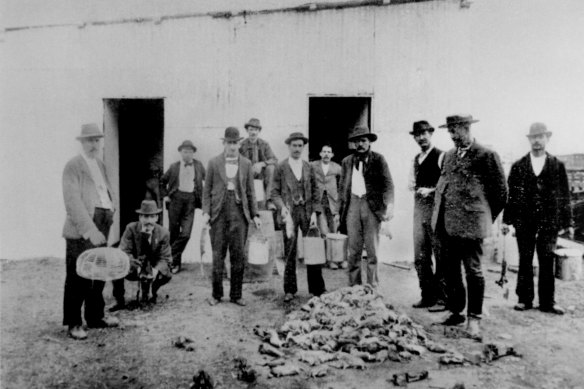
Officials and health workers inspect a mound of dead rats during the bubonic plague of 1900-02.Credit: State Library of Queensland
After many days the spell of quietness in connection with plague matters, which was promising soon to lull us into the idea that the enemy was subdued, was suddenly broken, and on Monday news came of fresh cases.
One victim is an eighteen-year-old youth, named Jones, who has been employed at a factory on a city wharf and resided with his parents at Cordelia Street, South Brisbane.
The case was isolated on Sunday night, and having been definitely pronounced plague, the patient was removed to the Plague Hospital on Monday morning, where he died on Tuesday afternoon.
There are eleven contacts in the case, consisting of the patient’s mother, father, and sisters and brothers.
They were removed to Colmslie, and the Joint Board’s cleansing gang commenced operations at the same time. The premises at Cordelia Street are under quarantine.
The other case of plague made its appearance in Kangaroo Point ward.
The victim was Mr. Edward H. M’Gregor, living with his wife and child at George Street, two doors from Main Street.
M’Gregor, who had been employed as an inspector by one of our leading insurance companies, was found to be in a very bad way, and the unfortunate man expired at an early hour on Tuesday morning.
The body was removed to Gibson Island during the morning by means of the special plague boat, and there interred.
The contacts in the case are the wife and child of the deceased only, and it has been decided to isolate them at their own home, instead of at Colmslie, the building being in every way suitable.
On Monday afternoon, James Drevesen, the first patient to be affected by the bubonic plague in Brisbane, was released from the Colmslie Quarantine Station yesterday afternoon, after a detention there of seven weeks.
Dr. Hutchens reports from the plague area at Colmslie on Wednesday, “All patients in the hospital are doing well.”
Dr Weild, from the contact area, seconds this good news by reporting “No illness amongst contacts.”
The bubonic plague: More deaths in Brisbane. First published in the Queenslander on June 16, 1900. Source: Trove
Riverfront for departed residents
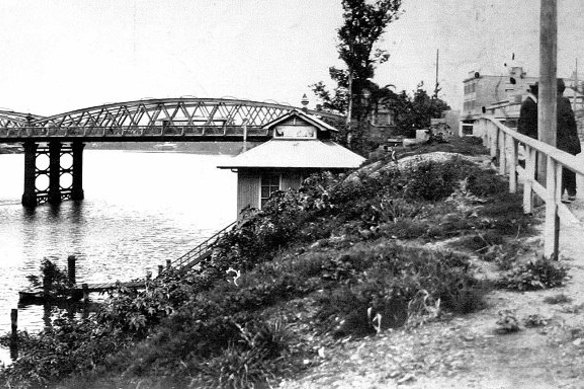
The 1910-1927 morgue on the Brisbane River bank as seen from Queen's Wharf Road, with the Victoria Bridge in the background.Credit: The Royal Historical Society of Queensland
Once more the site of the morgue is being changed.
When the flood waters swept down the river in 1893, the morgue building vanished from where it had been near the Queen’s Wharf.
For a time small shed on the south side was used, and then the Government enlarged the morgue at the Brisbane Hospital.
It was in 1911 that the building on the river bank just below the bridge was erected and now it is being removed to the foot of Alice Street.
Originally the cost was about £1,000, and today a little more than that sum will have to be expended in the changing of the site.
The principal reason for this is the necessity for strong foundations since the morgue will not be on the river’s edge and not perched high up on the bank, a disadvantage of the old site which was one of the reasons for the decision to move the building.
There were other reasons. The city council has a scheme for the beautification of the river bank at North Quay and the presence of the morgue would be rather incongruous.
Then it has been suggested that the blind street below the level of William Street would make an excellent parking station.
That is why workmen are now busy putting in deep concrete foundations where Alice Street meets the river, while others are dismantling the 50 x 16 building at North Quay.
Unusual incidents
The caretaker (Mr. R. Morris) was busy in his temporary premises when a representative of The Telegraph called on him.
“Yes,” he said, “there have been many queer incidents at the morgue during the years I have been in charge.”
All police cases, he explained, are taken to the morgue for the post-mortem examination, and during the 16 years, the building was at North Quay as many as 2000 were dealt with.
All these, of course, were not court cases. Great numbers had to do with suicides. Brisbane, while astonishingly free from crimes of murder, has each year a considerable number of cases of suicide.
On occasions, the number shows temporarily a large increase. For instance, towards the end of the war and in the period which immediately followed it, there was an increase in suicides, mostly among ex-servicemen. Most of them chose the river.
There is, however, a great decrease in the number of deaths by drowning compared with the figures for 20 years ago.
Not all of these are suicide cases; dozens on men, down-and-out, have sought forgetfulness in drink and stumbled to the river bank to sleep.
An uneasy dream, a slight shifting of position, and the river has another victim.
Pitiful scenes have been witnessed when a broken body has awaited identification, and the greatest care has to be taken to ensure that the identification is accurate.
Some years ago a woman was found dead at Red Hill. Twelve persons identified the body as that of a certain woman, among them a hotelkeeper who said that he had seen her in his building on the previous day.
Identification seemed certain, when suddenly the other woman was found. It is not known to this day who was the unfortunate found at Red Hill.
Numbers go to the grave unknown. A detailed description is secured, but frequently it goes into the official file marked “Not identified.”
There are cases where success has been achieved. Recently the body of a man which had been found in Brisbane was identified by the description six months afterwards in Melbourne.
There was a poignant scene one day at the morgue. The body of a woman of the streets had been taken from the river and several of her companions had come to identify it.
They sat in the waiting-room, silent, deep in thought. One particularly seemed to be “doubting, dreaming: dreaming dreams no mortal ever dared to dream before.”
Suddenly she spoke, and the cultured voice was tragically incongruous with her attire. “My God,” she said, “must we all end like this.”
No terrors
There are others for whom the morgue has no terrors.
Frequently “dead-beats” have to be hunted from the place in which they have selected as a camping ground.
One venerable old gentleman patronised the building in ignorance.
He had carefully prepared a bunk beneath the building, neatly stowing his billy-can and pantry beside it.
He had been here night after night for a week when he was finally discovered, and, when he learned the purpose of the building, he did not stand upon the order of his going.
His mistake was a pardonable one, for the Brisbane Morgue is no gloomy building filled with shadows, but an airy place, which, liberally equipped with windows, is all day bright with Queensland sunshine.
The morgue: A place of queer scenes. First published in The Telegraph on January 14, 1928. Source: Trove
Floating baths float away
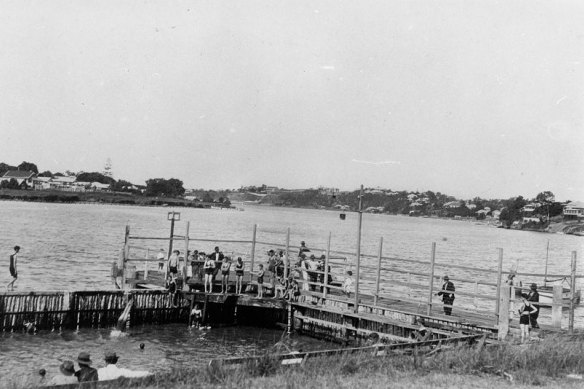
Taking a dip at Mowbray Park, East Brisbane in the 1920s.Credit: State Library of Queensland
Though the Brisbane River was considerably swollen on Saturday, the expected flood did not materialise, none of the wharves being submerged.
The Brisbane City Council’s floating baths, which were insured for £1200, were swept away in the early hours of Saturday morning, despite the fact that they had been secured with additional hawsers.
They crashed into the bows of the steamer Morton without doing the steamer any apparent damage.
The unwieldy structure then commenced a wild rush downstream. It narrowly missed several small craft, and then crashed into the hull of the old steamer Bingera, again doing only damage to the runaway itself.
Finally the baths commenced to break up in the swirling waters, and timber was strewn along the river bank for miles, while other portions were swept to sea.
Although a big rise took place in the upper reaches of the Mary River on Friday, Maryborough, at its mouth, was not flooded, as at first appeared probable.
Fifty acres of cultivated flats at Indooroopilly, Brisbane, were inundated on Saturday, and crops of lucerne, chaff and potatoes ruined.
An eight-year-old boy, Thomas Major, who went for a swim in a creek running through Graceville Reserve, Brisbane, was drowned.
Swept away: Brisbane council’s floating baths. First published in The Singleton Argus on April 24, 1928. Source: Trove
Disaster strikes on the Brisbane River
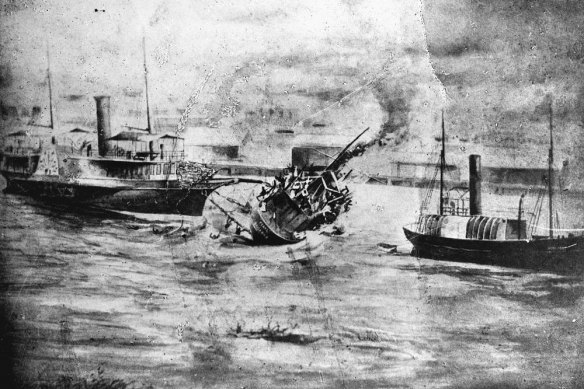
Wreck of the Pearl off the South Brisbane bank of the Brisbane River.Credit: State Library of Queensland
The only event of recent years which can be compared with the wreck of the SS "Pearl", on Thursday, the 13th instant, is the wreck of the "Quetta," in 1891, and even that, although resulting in a larger loss of life, was perhaps less keenly realised in Brisbane, by reason of its farawayness, than was the disaster of last week, which happened at our own doors, and was seen with agony by many, probably hundreds, who were unable to stretch out a hand to save those who struggled before their eyes for dear life.
The story of the wreck is brief enough, brief as such sad occurrences often are. The heavy rains in the watershed of the Brisbane and the Stanley rivers had resulted in a strong fresh in the river in town. This fresh could have caused no great concern if it had not been accompanied by the floating-down of a large amount of timber and other debris. This by a most mischievous neglect was allowed to reach the piles of the temporary portion of the Victoria Bridge.
The beginning of collection at the piers being thus made possible, the mass increased rapidly and largely, and soon a huge mass of matter lay on the upstream side of the bridge; and this pressing strongly against the relatively frail structure threatened serious damage, if not actual destruction.
At about noon on Thursday, damage ensued, and a portion of the wooden bridge sank; and at once all traffic was stopped.
That stoppage rendered necessary the transit of passengers over the river by means of steamers plying between Queen's Wharf and the Musgrave Wharf.
Throughout the afternoon two or three small steamers were employed in the business. It must be remembered that the current was strong; and as ill luck would have it the SS "Normanby" was anchored in, mid-stream, in or near the direct track between the two points of the service; and at a point somewhat lower down, but nearer to the southern bank, and almost in a line with the Musgrave Wharf, lay the two government steamers, "Lucinda" and "Otter," they having been moored there for safety as had been the case in previous river freshes.
Without accident, the ferry service went on through the afternoon until near 5 o'clock, when the "Pearl" in crossing, narrowly escaped damage or wreck on the bows of the "Lucinda." Undeterred by this escape, she was taken on her next and fatal trip, when she left the Queen's Wharf about 5 o'clock, with probably over 80 passengers aboard. Steering close astern of the "Normanby" she, it is said, grazed that vessel, and then steering towards the " Lucinda", she attempted again the course which had been proved dangerous.
The current was strong and set her down towards the " Lucinda," and not until quite near was it realised that could not pass in front. An attempt was then made to alter the course, but it proved too late, for she was taken by a pitiless current, with a giant's strength, and forced on to the taut anchor cable of the "Lucinda." Probably cut into two parts, she, in less than a minute, turned over with, as it were, face upstream away from' the "Lucinda," and Bank.
"Then rose from river to sky the wild farewell,
Then shrieked the timid, and stood still the brave,
Then some leaped overboard with dreadful yell."
Not soon will that wild cry be forgotten by those who heard it. Strong men, well known in the city, young girls going home from school, young men and young women in the strength, pride and hope of life, and little ones just looking out on life, all in one mixed struggling mass, fighting for life in a rushing, remorseless-current.
What a sight!
As by magic, there at once shot out from each bank, boats of all sorts, bearing men anxious to save life and to that prompt effort is due the saving of many.
But alas there were many whom no effort could save and these make up the sad, sad tale of the doleful disaster. As the days have passed the record of the saved and of the dead has been slowly filling, until at the time of this writing the number of the former stands at about 59, and of the latter at about 25, the bodies of 12 of whom have been discovered, leaving 13 undiscovered.
It may, of course, be that others may yet prove to be missing since it is not possible to learn how many were on board on that last sad trip. This feature of the happening recalls the account given by Tacitus of the collapse of the amphitheatre at Fidena, as given in the vigorous translation by Gordon, "one bewailed his brother, one his kinsman, another his parents; even they whose friends or kindred were absent on a different account, were yet terrified; for as it was not distinctly known upon whom the destruction had lighted, the dread was widened by uncertainty."
The heart of the community goes out in pity for the ill-fated, and in sympathy with the bereaven. None the less does it demand that diligent inquiry be made whether blame should rightly fall on any, and if on any on whom, for this desolation of so many hearts and homes.
The Pearl Disaster. First published in the Moreton Mail on February 21, 1896. Source: Trove.